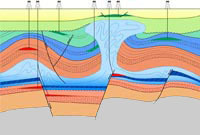
Energierohstoffe Erdöl und Erdgas
to english version:
Erdöl und Erdgas gehören zu den Kohlenwasserstoffen, einer Stoffgruppe von Verbindungen, die aus Kohlenstoff und Wasserstoff bestehen.
Die Kohlenwasserstoffgeologie befasst sich mit den geologischen Aspekten der Entstehung, Suche (Exploration) und Ausbeutung (Produktion) von Erdöl- und Erdgaslagerstätten.
Erdöl und Erdgas sind fossile Rohstoffe mit einer weltweiten Verbreitung. Ihr Ursprung geht auf Kleinstlebewesen und Pflanzen zurück, die vor Millionen von Jahren im Meer und an Land in unterschiedlichen Perioden der Erdgeschichte abgestorben sind und sich in den so genannten Muttergesteinen angereichert haben. Erdöl entstand dabei vor allem aus Algen, Erdgas vorwiegend aus abgestorbenen Pflanzenteilen.
Im Verlauf der Erdgeschichte lagerten sich auf den Muttergesteinen weitere Sedimentschichten ab, was zu Absenkungen von mehreren tausend Metern führte. Bei entsprechend hohen Temperaturen wandelten sich dabei die organischen Substanzen unter komplexen geochemischen Prozessen in Erdöl und Erdgas um. Diese Kohlenwasserstoffe wanderten im Laufe der Zeit in durchlässige Speichergesteine ein und reicherten sich unter günstigen Voraussetzungen in Fallen unter undurchlässigen Deckschichten an - es bildeten sich Lagerstätten.
Auch in Deutschland gibt es zahlreiche Erdöl- und Erdgaslagerstätten. Die wichtigsten Erdöl-Förderprovinzen liegen in Niedersachsen und Schleswig-Holstein. Hierbei wird das meiste Erdöl aus Sandsteinen der erdgeschichtlichen Perioden des Jura und der Kreide gefördert.
Niedersachsen ist das Zentrum der deutschen Erdgasförderung. Hier sind es im Wesentlichen Sandsteine und Dolomite des Perm sowie Sandsteine der Trias, aus denen das Erdgas gefördert wird.
Der Status der Erdöl- und Erdgasexploration und –produktion, aber auch der untertägigen Speicherung von Erdgas in Porenspeichern, ist ausführlich im jährlich erscheinenden Bericht "Erdöl und Erdgas in der Bundesrepublik Deutschland" beschrieben.
Exploration, Produktion und Speicherung von Erdöl und Erdgas sowie alle mit diesen Tätigkeiten verbundenen Maßnahmen werden von staatlicher Seite durch Auflagen und Gesetze geregelt. Auf den Grundlagen von Bundesberggesetz und Geologiedatengesetz (in der Vergangenheit Lagerstättengesetz) werden die bei der Aufsuchung und Gewinnung von Kohlenwasserstoffen erlangten Informationen an das Landesamt für Bergbau, Energie und Geologie übermittelt.
zur deutschen Version:
Oil and gas energy resources
Oil and gas belong to the hydrocarbon family, a group of substances consisting of compounds of carbon and hydrogen.
Hydrocarbon geology is engaged with the geological aspects of the genesis, search for (exploration) and exploitation (production) of oil and gas deposits.
Oil and gas are globally distributed fossil resources. Their origin can be traced back to the tiniest life forms and plants, which died in different geological periods, millions of years ago, in the oceans and on land, and then accumulated in what are referred to as source rocks. Oil primarily originates from algae, gas predominantly from decaying plants.
During the course of geological history additional sedimentary strata were laid down on top of the source rock, forcing the source rock to sink several thousands of metres. If temperatures are high enough the organic substances are converted to oil and gas in complex geochemical processes. With time, these hydrocarbons migrated into permeable reservoir rocks and, given favourable conditions, accumulated in traps below impermeable capping strata (cap rocks) - deposits formed.
Germany also has numerous oil and gas deposits. The most important oil producing provinces are in Lower Saxony and Schleswig-Holstein. The majority of the oil is produced from Jurassic and Cretaceous sandstones.
Lower Saxony is at the centre of German gas production. Here, the gas is predominantly produced from Permian sandstones and dolomites, and Triassic sandstones.
The status of oil and gas exploration and production, and the state of underground gas storage, is described in detail in the Erdöl und Erdgas in der Bundesrepublik Deutschland report (Oil and Gas in the Federal Republic of Germany), published annually.
Exploration, production and storage of oil and gas, as well as all other measures connected with these activities, are regulated by the government through regulations and laws. The information gained during the exploration and production of hydrocarbons is passed on to Landesamt für Bergbau, Energie und Geologie (State AuthorityA for Mining, Energy and Geology) as required by the Federal Mining Act and the Geological Data Act (in the past Act Mineral Deposits).
Erdöl- und Erdgaslagerstätten
Artikel-Informationen


